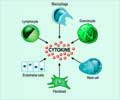Johns Hopkins researchers studied the activity and the major role played by the tumor necrosis factor (TNF) molecule in the activation of the immune system.
Johns Hopkins researchers studied the activity and the major role played by the tumor necrosis factor (TNF) molecule in the activation of the immune system to combat infections. TNF is a common protein which delivers warning message to cells in case of an invasion by a bacteria or virus. Then the TNF activates the body's immune system to fight the infection. The researcher said that further studies will enable us to understand and develop better treatments against the diseases when the immune system overreacts or pays too little attention to the infection alarm.
The Johns Hopkins researchers in association with the researchers at the University of California and San Diego developed a new computer model. This would produce medications for immune system-related ailments including septic shock, cancer, lupus and rheumatoid arthritis. The findings of the research were published in the journal Biological Chemistry. Andre Levchenko, a Johns Hopkins assistant professor of biomedical engineering and senior author of the paper said that cells are very sensitive to a brief exposure of TNF. He said that the research would benefit the drug companies to come up with drugs to regulate the immune response levels.Levchenko's team addressed mainly to the innate immune response that is a localized reaction that occurs to stop an infection threat confined to a small part of the body. This is of great contrast to a systemic response that triggers an immune reaction throughout the body, causing a fever. If the immune system responds too aggressively it results in a dangerous condition called septic shock.
White blood cells detect a bacterial intruder or toxin in the body which results in the produce of TNF. This carries a message about this health threat to the neighboring blood vessel cells, asking them to join in the fight. The message is sent by a TNF molecule attaching onto the surface of a neighboring cell and accesses a biological information highway called the NF-kappaB pathway. TNF's message moves along this pathway from the cell's surface to its nucleus. Inside the nucleus, the NF-kappaB molecules switch on the genes that produce infection-fighting proteins. These proteins fight the invaders by sending more white blood cells to engulf the bacteria or toxins. Sometimes the proteins produce inflammation, characterized by redness, swelling and pain.
This cellular signaling system of the TNF molecule is a very weak radio transmitter. It moves very slowly and is unable to send that message over long distances. But Levchenko said that the cellular pathways that pick up this signal act like extremely sensitive radio receiver which is a very smart strategy on the part of the cells.
Raymond Cheong, a graduate student in Levchenko's lab and lead author of the journal article said that a better understanding of why the fight against a local infection stays local is necessary otherwise it can cause drastic reactions.
The researchers found that when the TNF's warning message travels from the surface of a cell to its nucleus a molecule called Inhibitor of KappaB Kinase (IKK) plays a very important role. IKK carefully controls the level of the immune system's response. Hence by altering this molecule one can develop new medications designed to boost or suppress the immune system.








